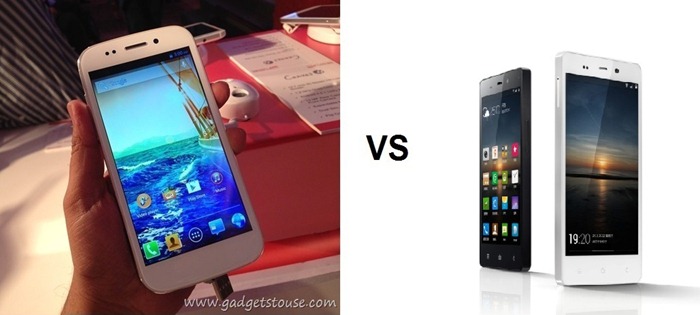Weight and Dimensions
Both devices come with 5 inch screens, so you can expect to have similar footprints as well. The Canvas 4’s dimensions are 144.5 x 73.8 x 8.9 mm, making it quite a thin device. On the other hand, the Gionee Elife E6’s dimensions are 142.5×69.4×7.9 mm, making it an even thinner device. During the time we spent using the Elife E6, we were particularly impressed with the device thanks to the rather low thickness and the surprisingly low weight of only 128g as compared to 158g on the Canvas 4.
Display and Processor
The Elife E6 comes with a superb 5 inch display with a full HD resolution of 1920×1080 pixels. On the other hand, the Canvas 4 comes with a 720p display on the same panel size. This means that the pixel density on the Elife E6 will be much greater due to more than double the number of pixels on an equally sized screen. The Elife E6 beats the Canvas 4 on the processing front as well, with it’s 1.5 GHz quad core MT6589T processor as opposed to the older MT6589 on the Canvas 4 which runs at 1.2 GHz per core. The Elife E6 comes with 2GB of RAM, which is exactly the double amount of what the Canvas 4 has on offer, at 1GB.
Camera and Memory
Both these devices come with a 13MP rear plus 5MP front camera setup, so choosing one will be tough. However, there is a slight chance that the Elife E6 will have a better image output due to the better software optimizations. The Elife E6 comes with Gionee’s own Amigo UI which bundles with it quite a few optimizations as well. The Elife E6 is more of a mixed bag when it comes to memory. It features 32GB of ROM which is double of what the Canvas 4 has on offer, at 16GB. However, the Canvas 4 comes with a microSD slot which the Elife E6 lacks.
Battery and Features
The battery department is one in which both these devices fall behind other competition. While the Canvas 4 features a 2000mAh unit, the Elife E6 does negligibly better with a 2020mAh unit. This means both the devices will probably need to be charged by evening. Hence, one out of the two cannot be chosen. Both devices come loaded with goodies in the UI. While the Canvas 4 does some new (at the time of its launch, of course) features like shake to unlock, blow to unlock, etc. On the other hand, the Elife E6 doesn’t budge as well. The phone’s Amigo UI offers some great and ergonomic gesture controls.
Key Specs
Conclusion
We are highly impressed with the screen and build quality on the Gionee Elife E6. Also, the fact that the phone comes with 32GB of ROM and 2GB of RAM adds to its value. However, Indians are only starting to accept Chinese companies like Gionee, which might hinder the sales of the device. On the other hand, the Canvas 4 from Micromax has been in the market for a while now and people know what to expect from it. And of course, the Canvas 4 has the advantage of being an ‘Indian’ device.
